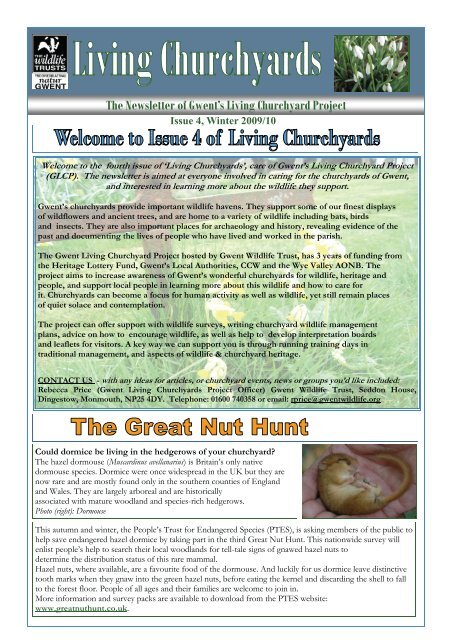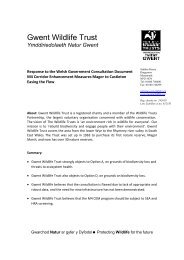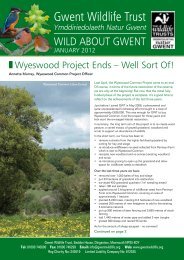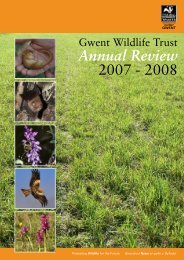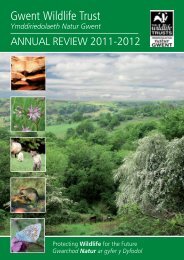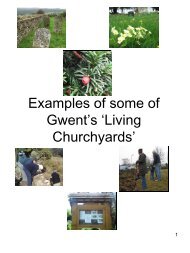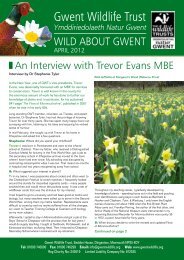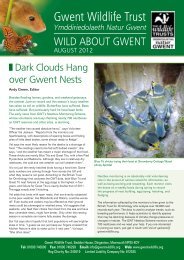GLCP newsletter Issue 4.pdf - Gwent Wildlife Trust
GLCP newsletter Issue 4.pdf - Gwent Wildlife Trust
GLCP newsletter Issue 4.pdf - Gwent Wildlife Trust
Create successful ePaper yourself
Turn your PDF publications into a flip-book with our unique Google optimized e-Paper software.
The Newsletter of <strong>Gwent</strong>’s Living Churchyard Project<strong>Issue</strong> 4, Winter 2009/10Welcome to the fourth issue of ‘Living Churchyards’, care of <strong>Gwent</strong>’s Living Churchyard Project(<strong>GLCP</strong>). The <strong>newsletter</strong> is aimed at everyone involved in caring for the churchyards of <strong>Gwent</strong>,and interested in learning more about the wildlife they support.<strong>Gwent</strong>’s churchyards provide important wildlife havens. They support some of our finest displaysof wildflowers and ancient trees, and are home to a variety of wildlife including bats, birdsand insects. They are also important places for archaeology and history, revealing evidence of thepast and documenting the lives of people who have lived and worked in the parish.The <strong>Gwent</strong> Living Churchyard Project hosted by <strong>Gwent</strong> <strong>Wildlife</strong> <strong>Trust</strong>, has 3 years of funding fromthe Heritage Lottery Fund, <strong>Gwent</strong>’s Local Authorities, CCW and the Wye Valley AONB. Theproject aims to increase awareness of <strong>Gwent</strong>’s wonderful churchyards for wildlife, heritage andpeople, and support local people in learning more about this wildlife and how to care forit. Churchyards can become a focus for human activity as well as wildlife, yet still remain placesof quiet solace and contemplation.The project can offer support with wildlife surveys, writing churchyard wildlife managementplans, advice on how to encourage wildlife, as well as help to develop interpretation boardsand leaflets for visitors. A key way we can support you is through running training days intraditional management, and aspects of wildlife & churchyard heritage.CONTACT US - with any ideas for articles, or churchyard events, news or groups you’d like included:Rebecca Price (<strong>Gwent</strong> Living Churchyards Project Officer) <strong>Gwent</strong> <strong>Wildlife</strong> <strong>Trust</strong>, Seddon House,Dingestow, Monmouth, NP25 4DY. Telephone: 01600 740358 or email: rprice@gwentwildlife.orgCould dormice be living in the hedgerows of your churchyard?The hazel dormouse (Muscardinus avellanarius) is Britain’s only nativedormouse species. Dormice were once widespread in the UK but they arenow rare and are mostly found only in the southern counties of Englandand Wales. They are largely arboreal and are historicallyassociated with mature woodland and species-rich hedgerows.Photo (right): DormouseThis autumn and winter, the People’s <strong>Trust</strong> for Endangered Species (PTES), is asking members of the public tohelp save endangered hazel dormice by taking part in the third Great Nut Hunt. This nationwide survey willenlist people’s help to search their local woodlands for tell-tale signs of gnawed hazel nuts todetermine the distribution status of this rare mammal.Hazel nuts, where available, are a favourite food of the dormouse. And luckily for us dormice leave distinctivetooth marks when they gnaw into the green hazel nuts, before eating the kernel and discarding the shell to fallto the forest floor. People of all ages and their families are welcome to join in.More information and survey packs are available to download from the PTES website:www.greatnuthunt.co.uk.
A number of churchyards in <strong>Gwent</strong> are already managed with wildlife in mind, and more are startingon the journey. Here’s a little of what’s been happening locally (or is happening!) this year. Please letme know of any local churchyard events you’re planning, or if you’d like to contact one of the groups.Ebbw Vale Cemetery Biodiversity Blitz Day!Ebbw Vale Cemetery was the venue in July for a day of wildliferecording. This was one of a number of ‘Biodiversity Blitz’ Daysorganised by the South East Wales Biological Records Centre(SEWBReC), at sites around <strong>Gwent</strong>, with the aim to bring together asmany wildlife experts as possible to record all the wildlife they see!Ebbw Vale Cemetery heralded 304 species records, with 225 newspecies for the site! This helps to show just how much wildlife ourcemeteries and churchyards can support. Probably one of the mostexciting records was that of an adult brown hawker dragonfly.The cemetery is cared for by Blaenau <strong>Gwent</strong> County Borough Council.Thanks to the encouragement of local naturalists, and Blaenau<strong>Gwent</strong>’s Ecologist, management within part of the site changed in 2007from intensive cutting to an annual hay cut and removal of cuttings.This change in management has resulted in an increase in speciesdiversity and part of the site is now a wild flower conservationarea. The site also supports mature tree, scrub and stream habitats andis a local oasis for wildlife.Caring for God’s Acre Wye Valley Churchyards ProjectWith funding from the Wye Valley AONB, the successful Caring for God’s Acre Project (based in Leominster) are todevelop a leaflet for visitors to the Wye Valley, highlighting its rich array of churches and churchyards. If you are in theWye Valley and wish your churchyard to be included please see www.caringforgodsacre.co.ukSt Michael’s and All Angels, Llantarnam - a collection ofphotos to celebrate ‘the passing of the seasons’Inspired by the wildlife to be found in their churchyard Roger &Myra Alma have compiled a CD of photos taken throughout theyear within the churchyard at St Michael’s and All AngelsLlantarnam. The photos provide a visual record of the passing ofthe seasons in the churchyard, and allow others to share in theseasonal highlights. <strong>Wildlife</strong> highlights include the spring display ofprimroses, violets and lesser celandine (photo, right).If you’d like to learn more about the churchyard or join the team ofpeople who work to make it a beautiful and tranquil place see:www.stmichaels-llantarnam.co.uk/Churchyard.htmSt Illtyds Moth NightLocal naturalist Luke Phillips shared his knowledge and enthusiasm formoths with a moth trapping session at St Illtyds Churchyard on theevening of the 26th August.In Britain we only have about 50 different kinds of butterfly but more than2,500 different sorts of moths. Moth traps were used to lure in thesenocturnal creatures which come in an often surprising variety of colours &patterns.Elephant hawk moth (photo, left)PHOTOGRAPHY COMPETITION EXHIBITIION, St Mary’s Church, PenterryFollowing the success of their 2008 photography competition, the Friends of Penterry Church repeated thecompetition in 2009. The theme was ‘The Living Landscape’ and was open to both amateur and professionalphotographers of all ages. An exhibition of entrants was held at St Arvan’s Village Hall on Saturday 5thSeptember. For more information see www.penterry.org.uk/?p=photo_comp
<strong>Gwent</strong>’s Living Churchyards Project can help with money for training courses, walks & talks by localexperts and churchyard events to help you learn more about your churchyard’s wildlife & heritage.Money for training to suit your needs and interests...♦ The programme of trips and training for 2010 is currently being developed. If you have an idea for atraining course at your churchyard or have seen a training course elsewhere you’d like to attendplease let me know.♦ Churchyard Volunteer Groups - remember we can reimburse refreshment costs or help fund first aidor practical training courses (e.g. brushcutter, traditional scything).♦ <strong>Wildlife</strong> & Heritage Events - The project can contribute to churchyard events you may be planningin 2010 e.g. help with teas & cakes, publicity costs, prizes, paying tutors to give walks/talks.Stone Walling CourseTwo day course – Saturday 20 th & Sunday 21 st February 2010- Practical course led by Brian Polson Professional Member & Qualified walling instructor of the Drystone WallingAssociation- The course run time is to be confirmed: 10.00am-3.30pm. The course may be shorter depending upon progress.- Venue: Groeswen Chapel, Caerphilly.Under the guidance of experienced stone waller Brian Polson, a section of Groeswen chapel yard’s wall will berebuilt using traditional techniques.FREE. BUT BOOKING IS REQUIRED.To book a place, please contact Rebecca Price: rprice@gwentwildlife.org or 01600 740358GAVO Monmouthshire is running a grant scheme called Active Communities, with revenue grants of between£2000 and £5000 available. Community led projects in Monmouthshire can apply, which enhance rural areas andcommunities.Projects should have a tangible and lasting benefit to the area or community, and should target specificgroups. 20% match funding is required. Grants can be used to fund the running costs of a project (not topurchase capital items), and there should be no tangible items left at the end of the project funded through thisgrant scheme.The closing date for applications is 31st January 2010, and projects should be complete by the end of December2010.For more information/application form please contact Jackie.Sturt@gavowales.org.uk or 01291 672352Monmouth’s Robert Stroud died in 1895 aged 93. He had acted as official trumpeter at the Quarterly Assize in theShire Hall for 65 years. Thanks to the detective work of Monica Leat, Secretary of Monmouth’s Field and HistorySociety and David Harrison, Local Historian, his last resting place has been rediscovered in Monmouth Cemetery.During the infamous Show Trial of the Welsh Chartists in 1839/1840, Robert Stroud accompanied the visitingJudges, the big-wigs who sat on the Special Commission to look into the charges of High Treason, on their dailyprocession. His trumpet sounded their approach from St James’ Mews and blasted the confined air of the LawCourts to announce the commencement of proceedings. Throughout the 17 days of this remarkable Trial, RobertStroud was in charge of the 12 accused men held in the Holding Cells below the Shire Hall. He cared for theirneeds and welfare without fear or favour.As was usual in 19 th century Monmouth the trumpeter did other work such as helping out on farms and makingand repairing boots and shoes. The evening of his days were spent at 12, Almshouse Street, Monmouth.Robert Strand features on Trail No.2 which is was produced by the Friends of Monmouth Cemetery in Summer2009. His serrated headstone clearly proclaims TRUMPETER for all to see.Article by David Harrison, Friends of Monmouth Cemetery 2009.


